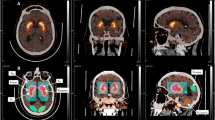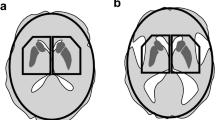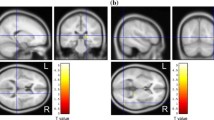Abstract
Purpose
The purpose of this study was to investigate the feasibility and utility of dual-isotope SPECT for differential diagnosis of idiopathic Parkinson’s disease (IPD) and multiple system atrophy (MSA).
Methods
Simultaneous 99mTc-ECD/123I-FP-CIT studies were performed in nine normal controls, five IPD patients, and five MSA patients. Projections were corrected for scatter, cross-talk, and high-energy penetration, and iteratively reconstructed while correcting for patient-specific attenuation and variable collimator response. Perfusion and dopamine transporter (DAT) function were assessed using voxel-based statistical parametric mapping (SPM2) and volume of interest quantitation. DAT binding potential (BP) and asymmetry index (AI) were estimated in the putamen and caudate nucleus.
Results
Striatal BP was lower in IPD (55%) and MSA (23%) compared to normal controls (p<0.01) , and in IPD compared to MSA (p<0.05). AI was greater for IPD than for MSA and controls in both the caudate nucleus and the putamen (p<0.05). There was significantly decreased perfusion in the left and right nucleus lentiformis in MSA compared to IPD and controls (p<0.05).
Conclusion
Dual-isotope studies are both feasible in and promising for the diagnosis of parkinsonian syndromes.



Similar content being viewed by others
References
El Fakhri G, Maksud P, Kijewski MF, Habert MO, Todd-Pokropek A, Aurengo A, et al. Scatter and cross-talk corrections in simultaneous Tc-99m/I-123 brain SPECT using constrained factor analysis and artificial neural networks. IEEE Trans Nucl Sci 2000;47:1573–80
El Fakhri G, Moore SC, Maksud P, Aurengo A, Kijewski MF. Absolute activity quantitation in simultaneous I-123/Tc-99m brain SPECT. J Nucl Med 2001;42:300–8
Hughes AJ, Daniel SE, Kilford L, Lees AJ. Accuracy of clinical diagnosis of idiopathic Parkinson’s disease: a clinicopathological study of 100 cases. J Neurol Neurosurg Psychiatry 1992;55:1009–13
Gilman S, Low PA, Quinn N, Albanese A, Ben-Shlomo Y, Fowler CJ, et al. Consensus statement on the diagnosis of multiple system atrophy. J Neurol Sci 1999;163:94–8
Friston KJ, Holmes AP, Worsley KJ, Poline JB, Frith C, Frackowiak R. Statistical parametric maps in functional imaging: a general linear approach. Hum Brain Mapp 1995;2:189–210
Cointepas Y, Mangin JF, Garnero L, Poline JB, Benali H. BrainVISA: software platform for visualization and analysis of multi-modality brain data. Neuroimage 2001;13:S98
Tzourio-Mazoyer N, Landeau B, Papathanassiou D, Crivello F, Etard O, Delcroix N, et al. Automated anatomical labeling of activations in SPM using a macroscopic anatomical parcellation of the MNI MRI single-subject brain. Neuroimage 2002;15:273–89
Swanson RL, Newberg AB, Acton PD, Siderowf A, Wintering N, Alavi A, et al. Differences in [99mTc]TRODAT-1 SPECT binding to dopamine transporters in patients with multiple system atrophy and Parkinson’s disease. Eur J Nucl Med Mol Imaging 2004;32:302–7
Thobois S, Jahanshahi M, Pinto S, Frackowiak R, Limousin-Dowseya P. PET and SPECT functional imaging studies in parkinsonian syndromes: from the lesion to its consequences. NeuroImage 2004;23:1–16
Bosman T, Van Laere K, Santens P. Anatomically standardised 99mTc-ECD brain perfusion SPET allows accurate differentiation between healthy volunteers, multiple system atrophy and idiopathic Parkinson’s disease. Eur J Nucl Med 2003;30:16–24
Acknowledgements
This work was supported in part by grants from the French Ministry of Health: FUSPARK project (Réseau National Technologie Santé), Partners Collaborative Research (grant 137561), and the National Institutes of Health (grants RO1-EB000802 and RO1-EB001989).
Author information
Authors and Affiliations
Corresponding author
Rights and permissions
About this article
Cite this article
El Fakhri, G., Habert, MO., Maksud, P. et al. Quantitative simultaneous 99mTc-ECD/123I-FP-CIT SPECT in Parkinson’s disease and multiple system atrophy. Eur J Nucl Med Mol Imaging 33, 87–92 (2006). https://doi.org/10.1007/s00259-005-1920-y
Received:
Accepted:
Published:
Issue Date:
DOI: https://doi.org/10.1007/s00259-005-1920-y




